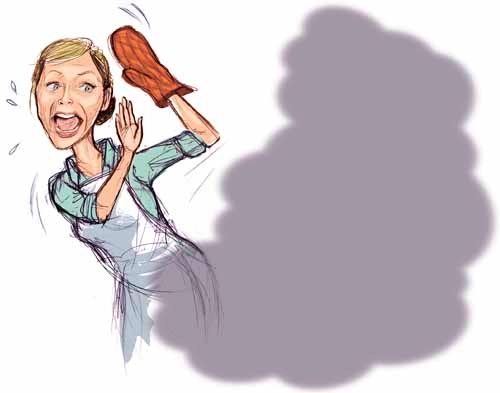TURKEY DAY DISASTERS: What to do
Thanksgiving dinner is one of those Big Events that tend to instill just a tiny bit of tension. For the novice, it stems from an unfamiliarity with the whole process, but for novice and veteran alike, the stress tends to be exacerbated by the expectations, real or imagined, of family and friends.
Which brings us to Thanksgiving disasters, those seemingly irreversible mishaps that are likely to trip up just about any cook. Today, on Thanksgiving eve, we're sharing a couple of secrets. One is that these mishaps are quite common. The other is that in most cases they're not irreversible.
Nicole Johnson, an expert with the Butterball Turkey Talk-Line (800-BUTTERBALL, or 800-288-8372), said one of the most sought-after bits of talk-line advice is what to do about a turkey that isn't quite thawed. Using the preferred method of thawing in the refrigerator, a frozen turkey requires about one day for every four pounds of bird. And so, Johnson said, if you have, say, a 24- to 26-pound turkey, "it's going to take a good six to seven days."
Since, as we just pointed out, Thanksgiving is tomorrow - tomorrow! - that means you could be in trouble if your turkey still is buried in the freezer.
Not to worry, though - at least not to worry too much. Johnson said a safe alternative is the cold-water bath, in which the wrapped turkey is submerged in cold water, which should be changed frequently. That method takes about 30 minutes per pound, so you're still talking about a thaw-out period of 12 to 13 hours if you've got a supersized turkey.
Chris Massella, room chef at Austin's at Texas Station, said an alternative is to put your turkey into a large (very large, in this case) pot, cover it with water, herbs and other seasoning, and simmer until it's soft.
"Get it out, rub it with butter and more seasoning, and bake it," he advised.
One caveat: Don't attempt to thaw your turkey at room temperature, which can lead to bacterial growth, which can lead to you and your guests ... well, you can figure out where this is going.
Another common talk-line problem, Johnson said, is an oven that suddenly has died. (Word to the wise: Appliance-repair technicians say there's a reason so many ovens quit right before a holiday: the self-cleaning mode, which stresses the range and can cause problems that will make the oven inoperable.)
So, what can you do if you have a thawed turkey, guests on the way and no oven? Johnson said talk-line staffers are trained to give advice in preparing turkeys using several methods, including electric countertop roasters, deep fryers, microwaves, barbecue grills, water smokers and convection ovens.
Microwave? Yup, Johnson said the turkey breast - particularly an attractive choice for smaller households - can be cooked in a microwave.
"That is more of a moist heat method, more of a steamed method," she said.
Butterball's recommended method remains roasting in an open pan at 325 degrees until the thigh meat is 180 degrees, breast meat 170 degrees and the center of the stuffing 165 degrees.
Gerald Trujillo, assistant executive chef of the Luxor and the Excalibur, said sometimes people don't have room in their ovens for a whole turkey. He suggests buying turkey parts in that case. If it's too late when you find out that the turkey won't fit, try an alternative cooking method or cut the turkey into smaller pieces.
Sometimes, Johnson said, the roasting of a turkey will be interrupted because of, say, a family emergency (the chef cutting off his or her finger comes to mind). In that case, she suggests calling the talk-line, and the experts will ask pertinent questions (How long was it in the oven? What temperature did it reach?) and guide you appropriately.
"We're all working an eight-hour shift on Thanksgiving," she said.
Here are a few more emergency recovery tips from the experts:
If somehow you forget to buy a turkey until the last minute, Massella advises buying turkey parts, which are quicker and easier to prepare. Just add the appropriate seasonings, he said.
If you burn the skin, take it off, said Robert Butler, executive chef at Cafe Ile St. Louis at Paris Las Vegas (and recent World Food Championship winner). "You'll lose the 'wow' factor at the table," he said, "but take the burned skin off, slather it (the turkey) with butter, shallots and any fresh herb, cover it with foil and continue the cooking process." (Even if the skin is burned, the meat might not be properly cooked, he said.)
If you overcook the turkey, Trujillo said, slice it and put it in a shallow pan with some chicken stock. Cover and put it in the oven at about 200 degrees until it's hot. The stock, he said, will help replenish the lost moisture.
If you drop the turkey, Trujillo advises cutting away the part that hit the floor. Massella advises removing all of the skin, giving the turkey a quick rinse, brushing it with butter and herbs, and returning it to the oven to brown.
If your mashed potatoes get gluey, Butler suggests putting them in a casserole dish and putting buttered bread crumbs on top. "Almost turn it into a scalloped-potato idea," he said.
To keep mashed potatoes from getting cold - in which case they'll probably get glutinous and sticky - Trujillo recommends putting them back into the pot and holding them in the oven over low heat.
If you burn the potatoes and have to start over at the last minute, Massella said you should take more potatoes, cut them into small pieces, put them in a microwave-safe dish with a small amount of water, wrap the dish in plastic wrap and microwave until the potatoes are cooked, then mash as usual with heavy cream, butter, salt and pepper.
If you don't have enough juices to make gravy (or you ruin your gravy), Massella said you should take what juices you do have, supplement with chicken broth, thicken with a roux of flour and butter, and strain.
If your pan drippings are all black, Butler said, take some of the skin and meat from the bottom of the turkey, add some white wine to remove some of the bitterness if it's burned, and build the gravy from there.
If you ruin your cranberry sauce, Massella suggests taking some cranberry juice and reducing it in a pan, adding frozen cranberries, and a slurry of cornstarch and water to thicken.
If your gravy is lumpy, which Johnson said usually is caused by not using enough fat, she advises whirring it in the blender. Trujillo suggests putting it through a fine-mesh strainer or, if you have "small, pesky lumps," a food processor.
If you're serving canned jellied cranberry sauce, Butler said, "instead of just slicing it with the lines on it, mix it up with a little bit of orange juice, a touch of sugar and some of the zest."
If you have a fear of pie crust, Massella advises making a graham-cracker crust instead, baking it slightly and then baking it again with a pumpkin filling.
And a few final words of advice.
"Luckily, it's Vegas, so grocery stores are open," Butler said. "That's one positive."
"Keep your turkey away from the dog," he added.
And if struck by a cooking disaster so dire that it can't be remedied?
"You can come to a restaurant," Massella said. "No disasters at all."
Contact reporter Heidi Knapp Rinella at hrinella@
reviewjournal.com or 702-383-0474.

















